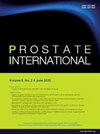游离PSA比值在PI-RADS<3、PSA≤10患者中提高临床意义前列腺癌检出率的作用
IF 2.6
2区 医学
Q2 UROLOGY & NEPHROLOGY
引用次数: 0
摘要
前列腺影像报告和数据系统(PI-RADS)评分低于3分且前列腺特异性抗原(PSA)水平为4-10 ng/ml的患者是否需要前列腺活检仍存在争议。我们测试了游离PSA比率(%fPSA)在PI-RADS <;3且PSA≤10 ng/ml患者中检测临床显著癌(CSC)的诊断性能。方法:我们分析了2018年4月至2023年1月在同一家机构由同一名操作员进行的1435例前列腺活检。采用活检当日或1个月内的PSA和游离PSA结果,所有活检均在前列腺磁共振成像(MRI)后进行。CSC定义为Gleason分级≥2组。结果在208例PI-RADS <;3且PSA≤10 ng/ml的男性中,有37例(17.8%)患者检出CSC。中位年龄为65岁(四分位数范围[IQR] 61-71),中位PSA水平为5.06 ng/ml (IQR 3.98-7.08),中位%fPSA为18.2% (IQR 13.7-22.0)。曲线下面积为0.757(95%可信区间为0.674 ~ 0.841),%fPSA截止值为17.6%,敏感性为86.5%,特异性为63.7%,阳性似然比(LR)为2.38,阴性似然比为0.21。114例%fPSA患者中有5例(4%)确诊为CSC,而94例%fPSA患者中有32例(34%)确诊为CSC,占17.6%。结论PI-RADS <;3和PSA≤10 ng/ml的患者,%fPSA值<;17.6%可能有助于那些可能不单独根据MRI结果进行活检的早期前列腺癌诊断。此外,当%fPSA超过17.6%时,PSA水平升高的患者可以避免不必要的活组织检查。本文章由计算机程序翻译,如有差异,请以英文原文为准。
Usefulness of free PSA ratio to enhance detection of clinically significant prostate cancer in patients with PI-RADS<3 and PSA≤10
Background
The necessity of prostate biopsy in patients with a Prostate Imaging–Reporting and Data System (PI-RADS) score below 3 and prostate-specific antigen (PSA) levels of 4–10 ng/ml remains controversial. We tested the diagnostic performance of the free PSA ratio (%fPSA) in detecting clinically significant cancer (CSC) in patients with PI-RADS <3 and PSA ≤10 ng/ml.
Methods
We analyzed 1435 prostate biopsies performed by a single operator between April 2018 and January 2023 at a single institution. PSA and free PSA results on the day of biopsy or within 1 month were used, and all biopsies were performed after prostate magnetic resonance imaging (MRI). CSC was defined as Gleason grade group ≥2.
Results
Among 208 men with PI-RADS <3 and PSA ≤10 ng/ml, CSC was detected in 37 (17.8%) patients. The median age was 65 years (interquartile range [IQR] 61–71), with a median PSA level of 5.06 ng/ml (IQR 3.98–7.08) and a median %fPSA of 18.2% (IQR 13.7–22.0). The area under the curve was 0.757 (95% confidence interval, 0.674–0.841), with a %fPSA cutoff of 17.6%, sensitivity of 86.5%, specificity of 63.7%, positive likelihood ratio (LR) of 2.38, and negative LR of 0.21. CSC was diagnosed in 5 out of 114 patients (4%) with %fPSA >17.6%, compared to 32 out of 94 patients (34%) with %fPSA <17.6%.
Conclusions
In patients with PI-RADS <3 and PSA ≤10 ng/ml, %fPSA values < 17.6% may facilitate early prostate cancer diagnosis in those who might not undergo biopsy based on MRI results alone. Additionally, unnecessary biopsies could be avoided in patients with elevated PSA levels when %fPSA exceeds 17.6%.
求助全文
通过发布文献求助,成功后即可免费获取论文全文。
去求助
来源期刊

Prostate International
Medicine-Urology
CiteScore
4.40
自引率
26.70%
发文量
40
审稿时长
35 days
期刊介绍:
Prostate International (Prostate Int, PI), the official English-language journal of Asian Pacific Prostate Society (APPS), is an international peer-reviewed academic journal dedicated to basic and clinical studies on prostate cancer, benign prostatic hyperplasia, prostatitis, and ...
 求助内容:
求助内容: 应助结果提醒方式:
应助结果提醒方式:


